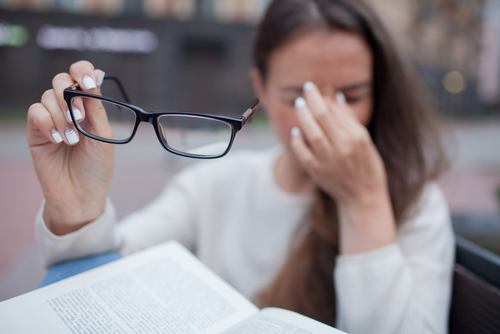July is National Dry Eye Awareness Month. Dry eye disease is an under-recognized condition and under-diagnosed condition affecting more than 30 million adults in the United States. For some, dry eye symptoms may feel like a speck of sand or dirt in your eye that just won’t go away. Because moderate to severe dry eye is associated with depression, significant levels of pain, and poor health, it’s important to schedule an exam with your eye doctor at Riverside Eye Center if you suspect you may have the condition.
Dry Eye Treatment
If your eye doctor confirms a diagnosis of dry eye, be sure to ask for dry eye treatment recommendations. For mild cases of dry eye, treatment options can include over the counter (OTC) artificial tears, medication changes to those that aren’t associated with dry eye, and cutting back on screen time (including TV, smartphones, and tablets). Warm compresses on the eyelid also can provide temporary relief. Your eye doctor may prescribe one of two FDA approved medications for dry eye treatment.
For moderate to severe cases of dry eye, your eye doctor may recommend surgery in which plugs are inserted into the inner corner of the eyes to prevent tears from draining, effectively correcting the problem.
No matter where on the spectrum you fall with your dry eye, it is recommended that you stop smoking if you are a smoker. Being constantly exposed to smoke from smoking can contribute to and aggravate existing symptoms of dry eye.
What Causes Dry Eye
Dry eye occurs when the surface of your eyes are no longer properly lubricated by tears. These tears are created by glands that are located near the eye. These tears, called basal tears, also help us see clearly by helping focus the light that we see. When the quality of our basal tears changes, dry eye occurs. This condition can also develop if the quantity of basal tears is reduced enough that the surface of the eye is no longer properly lubricated.
Symptoms Of Dry Eye
Common symptoms of dry eye syndrome can be:
- Scratchy sensation in the eyes
- Feeling like something is stuck in your eye
- Stinging of the eye
- Burning sensation
- Alternating periods of excess tears and dryness
- Redness of the eye
- Sensation of heavy eyelids
- Blurred vision
Risk Factors Associated With Dry Eye
- There are a variety of risk factors associated with dry eye, including high blood pressure, Parkinson’s disease, and autoimmune disorders such as rheumatoid arthritis, lupus, and thyroid disorders.
- The risk of dry eye increases with age, commonly affecting many people who are in their 50s and older.
- Women have a higher risk of developing dry eye than men due to hormonal changes associated with pregnancy and menopause, as well a higher risk of developing autoimmune diseases.
- Vitamin A deficiency and diabetes are also associated with the condition
- Seasonal allergies, windy or smoky environments are known to increase the rate of tear evaporation
- Anxiety medications, decongestants, and hormone replacement therapy (HRT) to reduce menopause symptoms also may be connected.
Dry eye can be annoying, especially when it begins affecting the way you live your life. Contact Riverside Eye Center in Auburn today to schedule your consultation with one of our expert doctors!

